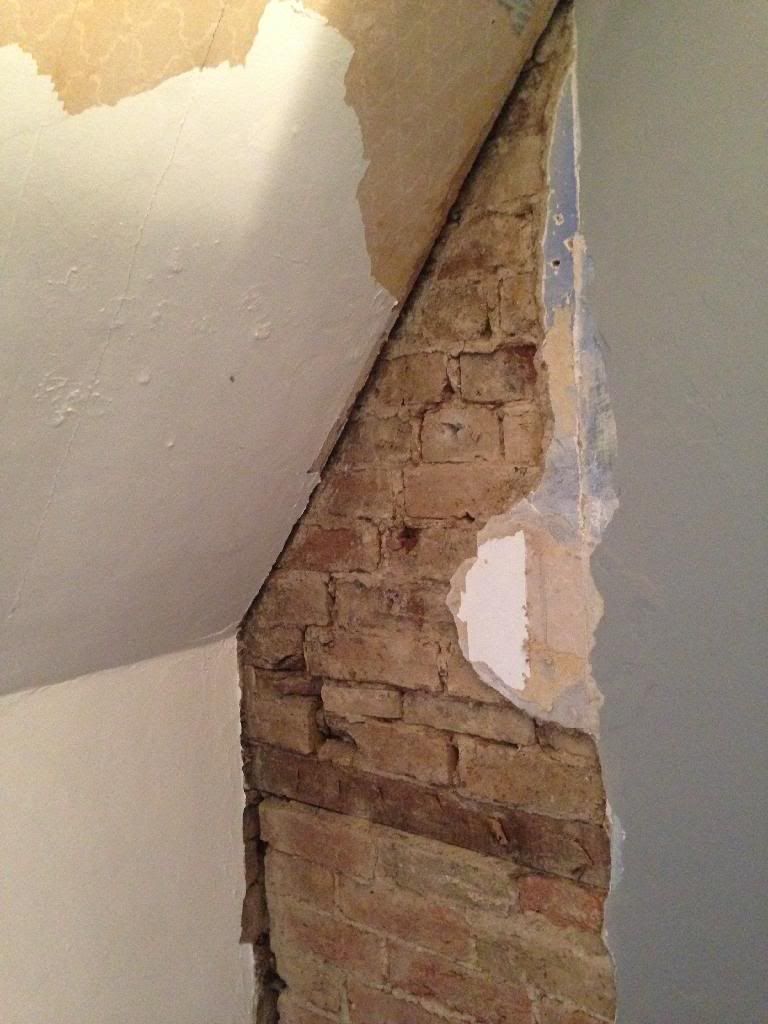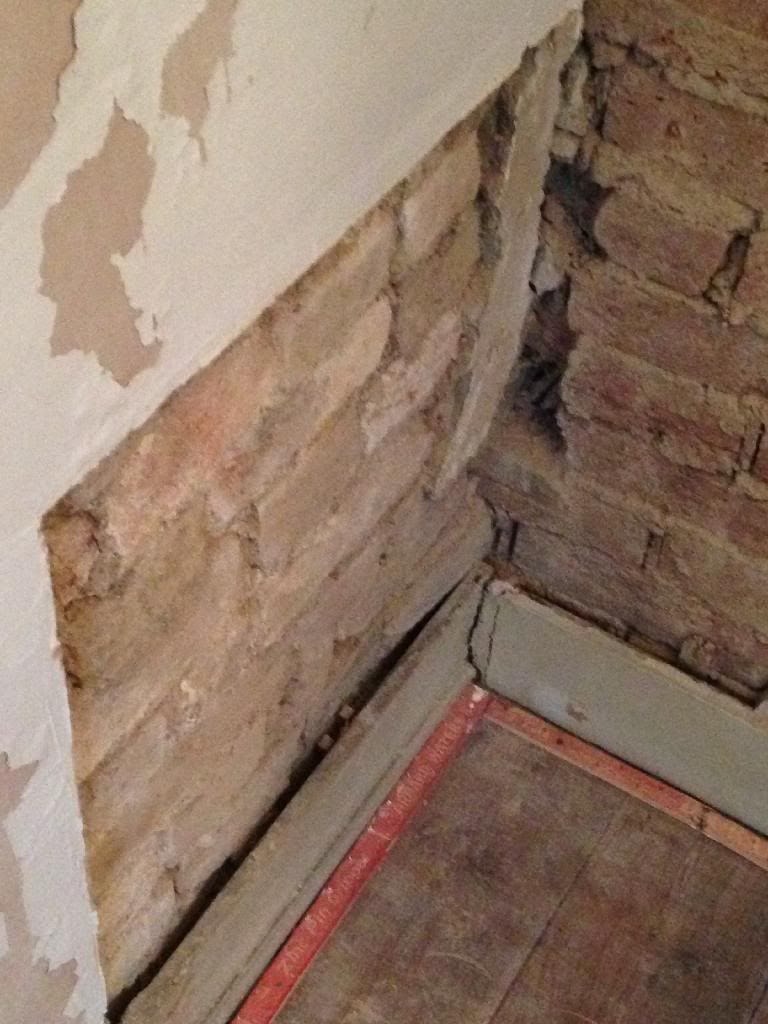
Plastering advice
Sierra - 25/4/14 at 05:43 PM
Hi all I'm in the process of doing up a house I just bought but when ripping out an old built in wardrobe I noticed all the plaster was crumbling
away and loose. I've peeled off the majority of loose plaster and I am now left with a brick wall around 15mm back.
What is the best method to use to replaster the brick wall up 15mm to join existing plaster.
The wall is an outside wall and very old (over 200 years)
Finish doesn't have to be perfectly flat as 1 the wall aren't flat anywhere in the house and 2 most of it won't be seen as another
wardrobe is being built.



Many thanks
JoelP - 25/4/14 at 06:15 PM
Expanding foam to fill the deep holes, bonding to bring it nearly level, skim over top. Pva the surrounding area before you skim. For the bonding just
thoroughly wet the bricks.
Simon - 25/4/14 at 06:23 PM
Having tried plastering, I'd say get a plasterer in to do it 
ATB
Simon
nick205 - 25/4/14 at 06:33 PM
quote:
Originally posted by Simon
Having tried plastering, I'd say get a plasterer in to do it 
ATB
Simon
Same here 
BenB - 25/4/14 at 06:39 PM
Unless you really like a challenge I'd also suggest getting in a plasterer. I've done a fair bit of plastering myself but it takes much
longer to DIY and it's never as good a finish as when you get a professional in. I tend to now only do small patches (stuff too small for a
plasterer to be interested in)- for large areas or high stuff (ceilings) I do some overtime with the time I would have spent plastering and get a
professional in 
But if you want to do it yourself I'd be tempted to whip the whole of the wall plaster off, dob and dab with some plasterboard and tape the joins
at the edges with some wickes skim plaster over the top of the edges then caulk it and paint....
cliftyhanger - 25/4/14 at 07:21 PM
If you really are not too worried I would do as Joel says. Foam and then bonding, though I would PVA the brickwork. And some metal mesh over the
timber. Use a board to get the levels a few mm lower than the existing walls, and later the same day have a go with some multi finish. A sander and
filler should get an acceptable finish.
But be aware, solid walls can be troublesome with modern plaster. The original lime stuff copes much better with damp. I know this from experience,
paying a plasterer and soon after hacking it off and batten/boarding with a vapour barrier.
Slimy38 - 25/4/14 at 08:26 PM
quote:
Originally posted by BenB
But if you want to do it yourself I'd be tempted to whip the whole of the wall plaster off, dob and dab with some plasterboard and tape the joins
at the edges with some wickes skim plaster over the top of the edges then caulk it and paint....
This would be my preference. It took half a dozen panels to redo a couple of walls in the bathroom in a couple of hours. It then cost less than £100
for a professional to skim, and I had a perfect surface for paint.
Someone did explain the benefit of a small air gap between brick and plaster, but I'm damned if I can remember it now!
fazerruss - 25/4/14 at 08:27 PM
That wall is in a bad state. It look like there is a wooden lintel in there so if you directly plaster over it is going to crack due to expansion
movement. You really ought to repair the wall first. Dig out 2 thirds of the depth of mortar and repoint a small section at a time. This will help
stop any cracking of the new plaster.
Plaster board dot n dab is a good way to give a nice new flat surface but you will need to do that entire wall to be even and not have a step. (9mm
board + the thickness of the adhesive which could be same again)
Sierra - 25/4/14 at 09:48 PM
Thanks for the advice. Can you plasterboard straight onto brick if it's an outside wall, I've heard people say not to.
S_D_C_2000 - 25/4/14 at 09:54 PM
Dot and dab worked fine for us in an old farmhouse, otherwise go for a thin batton.
cliftyhanger - 26/4/14 at 07:27 AM
I have seen damp patches where boards have been dottod on. Literally every dot had its own patch. If the wall is at all damp the modern plasters suck
the damp.
If perfectly dry no problem.
As above, these days I batten and board solid walls. Just in case.
HowardB - 26/4/14 at 07:38 AM
A word of caution. If that is very old mortar it may be incompatible with modern plaster. It will cause all sorts of issues. Guess how I know. ..?
jossey - 26/4/14 at 08:08 AM
Get cement to repair the holes first to save it getting damp again
Treat the walls before you do anything. Water seal....
Dot and dab the Board on. Get as level as poss and skim it.
Sierra - 26/4/14 at 10:10 AM
Could I wash it down in pva/water to seal it and then use this one coat plaster from wickes.
http://www.wickes.co.uk/One-Coat-Plaster-25kg/p/221806
It says that it can be applied upto 20mm which would be plenty and the finish doesn't have to be perfectly flat as the walls aren't
anywhere. Also 95% of it will be in a build in wardrobe so won't be seen, it's more to seal it off.
Smoking Frog - 26/4/14 at 10:16 AM
When I've came across jobs like this I was more concerned with the brickwork. The plaster (like cosmetic make-up) is just a pretty surface and
adds no structural integrity to the brickwork. Remove plaster make good brickwork re-plaster (I would batten and board as I guess it's a solid
wall with no cavity.
Sierra - 26/4/14 at 10:29 AM
Batten and board will be very difficult because the wall is very uneven with bricks coming out further in places. Would packing it in with the plaster
not strengthen all the bricks anyway by filling the holes. Or should I cement all the brickwork first
Smoking Frog - 26/4/14 at 12:58 PM
Yes, I can see it may be difficult for someone with little experience but this is the method I would use. Packing the bricks with plaster would never
be as good as mortar it tends to shrink on contact with brick especially old bricks like those which may be sponge like. A couple of good coats of a
PVA solution will help this.
steve m - 26/4/14 at 01:24 PM
If it was in my house, i would be inclined to to water proof/seal the exposed wall
attach battens to the brick work, and plaster board THE WHOLE WALL covering the damaged area's
This would give you a good flat area to skim over with plaster,
And as others have said, get a profesional in, as ive tried doing plastering, as it looks easy, and its NOT
steve
JoelP - 26/4/14 at 04:20 PM
A lot of overkill being advised imho. The wall is unlikely to just fall down. Just pva it and slop some plaster on. One coat plaster is fine if you
aren't too bothered about finish. Couple of hours and 10 quid including buying a crap float if you need. Don't make a mountain of it!
Scuzzle - 26/4/14 at 07:00 PM
A trick I've used on old walls is just to buy huge sheets of plasterboard and loads of tubes of Poundlands 'Hard as Nails' sealer (No
point paying £6 a tube for proper 'No More Nails, the Poundland stuff does not grab as well but when it sets it sets just as hard) and just bond
them onto the wall. I usually tidy any joins and wallpaper over it when done but it's a cheap and easy way to tidy bad walls up that you can do
yourself.
mark chandler - 26/4/14 at 08:57 PM
It looks to me like you have a running crack on the top half, if you plaster directly upon this it will be 'live' in a few months or a years
time.
First thing then is to drag out the old mortar and repoint to stabilise, after that it's your choice. I would pva and put on a coat of bonding,
once it's gone off then a coat of thistle multifnish.
Outside needs waterproofing as well and probably repointing.
The correct stuff is not expensive, the cheap one coat stuff usually leads to disappointment IMHO, I have never had any success anyway with it.
[Edited on 26/4/14 by mark chandler]





